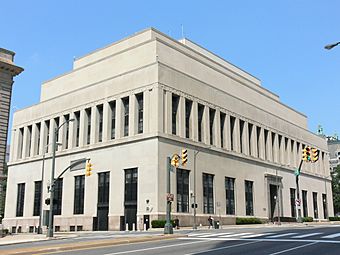Patrick Henry Building facts for kids
Quick facts for kids |
|
|
Virginia State Library
|
|

Patrick Henry Building, August 2005
|
|
| Location | 1111 E. Broad Street, Richmond, Virginia |
|---|---|
| Built | 1938-40 (interior rebuilt 2003-2005) |
| Architect | Baskervill & Son; Carneal, Johnson & Wright; Alfred Morton Githens & Francis Keally. |
| Architectural style | Stripped classicism |
| NRHP reference No. | 05000867 |
| Added to NRHP | August 9, 2005 |
The Patrick Henry Building is an important historic building in Richmond, Virginia. It used to be called the Old State Library or the Virginia State Library and Archives and Virginia Supreme Court. After being updated, it was renamed in honor of Patrick Henry. He was a famous founding father and a former governor of Virginia. The building was officially renamed on June 13, 2005.
Contents
About the Building's Design
This building is made of steel and covered with limestone. It was built in a modern style often called Art Deco or Stripped Classicism. These styles are known for being simple and grand. The outside of the building has very few decorations. This was done on purpose to make the nearby Virginia State Capitol stand out more.
The building has two main entrances. These show its original two purposes. There are also quotes from famous Virginians carved into its four sides:
- "The judicial department comes home in its effects to every mans fireside. It passes on his property his reputation his life his all." – John Marshall (on the north side)
- "Liberty and learning: both best supported when leaning on each other." – James Madison (on the east side)
- "Reason and free inquiry are the only effectual agents against error. They are the natural enemies of error and of error only." – Thomas Jefferson (on the south side)
- "A knowledge of books is the basis upon which other knowledge is to be built." – George Washington (on the west side)
Modern Updates to the Building
From 2003 to 2005, the building went through a big renovation. Workers kept the original entrances and many cool inside details. These included wood panels, marble, and copper light fixtures. But they also updated the plumbing, heating, and electrical systems. They also removed old, unsafe materials. The old library shelves that supported the building were replaced with new, modern supports. Some parts added in 1970 were also removed during this update.
History of the Patrick Henry Building
The Patrick Henry Building was built during the New Deal era by the Works Progress Administration. This was a program that created jobs during the Great Depression.
Past Uses of the Building
The building was first home to the Virginia Supreme Court. This court hears important legal cases in Virginia. The court moved to a new building in 1978. The entrance facing the Capitol used to lead to the Virginia State Library. This library is now called the Library of Virginia. It moved to a new building in 1996. Before this building, both the Supreme Court and the Library were in the Virginia State Library-Oliver Hill Building until 1939.
The building's old reading rooms were also used for a short time by the Virginia General Assembly. This happened in 2006 and 2007 while the Capitol building was being renovated.
Recognized as a Historic Place
In 2005, the building was added to the National Register of Historic Places. This is a list of important historical sites in the United States. It was added under its old name.
Special Historical Marker
In 2017, the Virginia Department of Historic Resources placed a special historical marker outside the building. This marker tells the story of Richard and Mildred Loving. They were a couple involved in a very important court case in 1967. This case, called Loving v. Virginia, changed Virginia's law against people of different races marrying.
The building was chosen for this marker because it was where the Supreme Court of Appeals heard the Lovings' case. The marker explains that the Lovings were married in Washington, D.C., in 1958. They were arrested in Virginia for breaking the state's marriage laws. They got help from the American Civil Liberties Union. Their case went all the way to the U.S. Supreme Court. In 1967, the Supreme Court decided that all state laws stopping marriage based on race were against the law.
What the Building is Used for Today
Today, the Patrick Henry Building is very busy. It holds the Governor's Working Office. It also has offices for Cabinet Secretaries and the Department of Planning and Budget. Some offices for the Department of General Services (DGS) are also located there.



